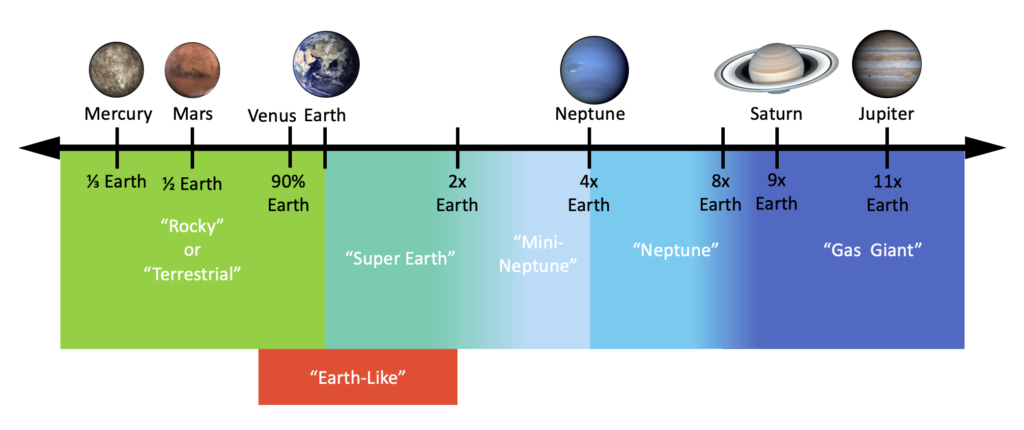If you keep up with astronomy news, you may have seen the recent announcements that the James Webb Space Telescope (JWST) is being used to observe distant exoplanets, discovering more about their atmospheres and composition than has ever been possible before. This summer, JWST observed a “Hot Jupiter” exoplanet called WASP-39 b, and found carbon dioxide in its atmosphere. NASA has planned several more observations of “Super Earth” planets like 55 Cancri e. These announcements beg the question: what does it mean when a planet is called a “Hot Jupiter” or a “Super Earth”? And what in the world is a “warm mini Neptune”? These interesting, descriptive phrases are used to describe certain observed exoplanets, but many of them require additional interpretation.
First off, these terms are not really technical terms. They have no exact meanings and are mostly meant as broad descriptors. The most important thing to remember is that these descriptions are applied based on observable properties. So while the term “terrestrial” means a planet made of primarily rocky material, it’s typically applied to all planets of a certain size, even when their composition is not known. This generalization is made because many exoplanet properties, like atmospheric or planetary composition, are hard to measure, so astronomers make assumptions about them based on estimates of a planet’s mass and gravitational pull. Therefore, we believe that most “terrestrial” planets are indeed made primarily of rocks, but without measurements of mass and composition, the only thing we know for sure is the size.
Gas Giants and Hot Jupiters
A gas giant is any planet that is about the same size as Saturn or bigger. Astronomers believe planets of that size are composed largely of hydrogen and helium gas. Like Saturn and Jupiter in our own solar system, these planets could have dense layers of clouds and swirling storms.
Hot Jupiters are a subset of gas giants, which orbit very close to their stars. In our solar system, Jupiter orbits about 460 million miles from the Sun, more than four times further than the Earth. Hot Jupiters orbit closer than even the innermost planets in our solar system. KELT-9 b, a particularly hot Hot Jupiter, is only 3 million miles away from its star, completing an orbit every 1.5 days. Because they are so big and so close to their stars, Hot Jupiters are the easiest type of planet to detect, so many of the exoplanets we have discovered are deemed Hot Jupiters.
Earth-Like
Another descriptor you might hear is “Earth-like”, which is admittedly one of the most loosely applied. An exoplanet might be described as “Earth-like” if it is anywhere from 80-200% the size of Earth. This is because planets in that size range are thought to be massive enough to hold onto an atmosphere, but not so large that they become gas giants like Jupiter or Saturn. And since this descriptor is so broad, it overlaps with other more-specific ones like “Super-Earth”, which is used to describe planets that are larger than Earth, but less than twice the size.
Rocky Planets
Rocky, or terrestrial, planets are those that are the same size as Earth or slightly smaller (like Mars, Venus, or Mercury). This size range contains a lot of variability as far as how nice it might be to visit. These planets might have an Earth-like atmosphere, or an extremely thick atmosphere, like Venus, or they might have none at all (like LHS 3844 b). They might have liquid water, frozen water, or no water at all. Lastly, they might orbit extremely close to their stars (like 55 Cancri e) or much further out.
Neptunes and Mini-Neptunes
In between the rocky planets and the gas giants are the Neptunes and mini-Neptunes. These are – you guessed it – planets that are roughly the size of Neptune (or smaller). “Mini-neptunes” are larger than twice the size of Earth, but smaller than Neptune itself (about 4x Earth’s size), while Neptune-like planets are about 4-8x larger than Earth. While very few “hot Neptunes” have been observed orbiting very close to their stars, astronomers have found several “warm Neptunes”, like the cloudless exoplanet HAT-P-26 b. These warm Neptunes orbit their stars a bit further out than Hot Jupiter-like planets, taking five or more days to complete an orbit.

Peer Editor: Devan Shell